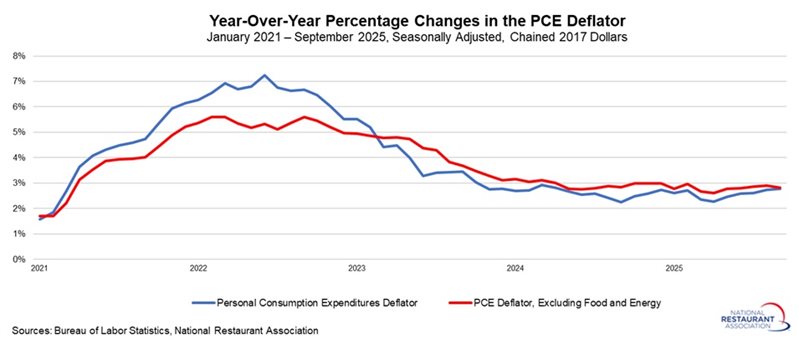Research
December 05, 2025
PCE Deflator
PCE Inflation Holds Steady as Consumers Spent Modestly in September
The Personal Consumption Expenditures (PCE) deflator—the Federal Reserve’s preferred inflation gauge—rose 0.3% in September for the second consecutive month, in line with market expectations. Food prices climbed 0.4%, following a 0.5% increase in August, while energy costs surged 1.7%, marking solid gains in three of the past four months. Core PCE, which excludes food and energy, advanced 0.2% for the third straight month.
Year-over-year, the headline PCE deflator increased to 2.8% in September, up from 2.7% in August and the highest since December 2023. Core inflation edged down slightly to 2.8% from 2.9% in August. Over the past 17 months—since May 2024—core inflation has averaged 2.8%, underscoring how earlier progress in easing price pressures has largely stalled. Still, both headline and core inflation remain well below their pandemic-era peaks of 7.1% (June 2022) and 5.5% (September 2022), though the Fed’s 2% target remains elusive.
For now, employment concerns are overshadowing inflation risks. The Federal Reserve is actively weighing further rate cuts while balancing economic resilience against still-elevated inflation. The Federal Open Market Committee is widely expected to lower the federal funds rate by 25 basis points at its December 9–10 meeting, with additional cuts likely in 2026.

Beyond prices, personal consumption expenditures rose 0.3% in September, easing from the 0.5% gains posted in each of the prior three months. Spending on foodservices and accommodations increased 0.5% in September after surging 1.1% in August. Over the past year, total personal spending has grown a solid 5.0%, with expenditures on foodservices and accommodations up 6.0% since September 2024, signaling surprising resilience in consumer demand despite persistent headwinds.
Part of this growth reflects higher prices, even as real spending continues to advance at a more modest pace. Inflation-adjusted personal consumption was flat in September but up 2.1% year-over-year. Real spending on foodservices and accommodations rose 0.3% for the month and 2.7% over the past year. Even after accounting for inflation, consumers are allocating more toward dining and travel, a positive sign for those sectors, albeit at a softer pace than many would prefer.

Personal income rose 0.4% for the second straight month in September, with 5.2% growth over the past 12 months. Solid wage growth has been a large contributor to the economy’s resilience.
Amid these trends, the personal savings rate was unchanged at 4.7% in September, the lowest since December. It is notable that the savings rate in the post-pandemic era remains lower than historic norms. From 2017 to 2019, the pre-pandemic average was 6.5%. Since the start of 2023, the rate has averaged just 5.4%.

Year-over-year, the headline PCE deflator increased to 2.8% in September, up from 2.7% in August and the highest since December 2023. Core inflation edged down slightly to 2.8% from 2.9% in August. Over the past 17 months—since May 2024—core inflation has averaged 2.8%, underscoring how earlier progress in easing price pressures has largely stalled. Still, both headline and core inflation remain well below their pandemic-era peaks of 7.1% (June 2022) and 5.5% (September 2022), though the Fed’s 2% target remains elusive.
For now, employment concerns are overshadowing inflation risks. The Federal Reserve is actively weighing further rate cuts while balancing economic resilience against still-elevated inflation. The Federal Open Market Committee is widely expected to lower the federal funds rate by 25 basis points at its December 9–10 meeting, with additional cuts likely in 2026.

Beyond prices, personal consumption expenditures rose 0.3% in September, easing from the 0.5% gains posted in each of the prior three months. Spending on foodservices and accommodations increased 0.5% in September after surging 1.1% in August. Over the past year, total personal spending has grown a solid 5.0%, with expenditures on foodservices and accommodations up 6.0% since September 2024, signaling surprising resilience in consumer demand despite persistent headwinds.
Part of this growth reflects higher prices, even as real spending continues to advance at a more modest pace. Inflation-adjusted personal consumption was flat in September but up 2.1% year-over-year. Real spending on foodservices and accommodations rose 0.3% for the month and 2.7% over the past year. Even after accounting for inflation, consumers are allocating more toward dining and travel, a positive sign for those sectors, albeit at a softer pace than many would prefer.

Amid these trends, the personal savings rate was unchanged at 4.7% in September, the lowest since December. It is notable that the savings rate in the post-pandemic era remains lower than historic norms. From 2017 to 2019, the pre-pandemic average was 6.5%. Since the start of 2023, the rate has averaged just 5.4%.
